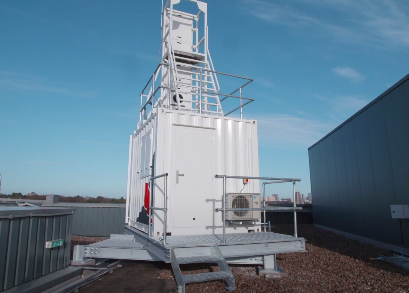UK manufacturer Aveillant has installed its holographic radar on top of an engineering building at the University of Birmingham as part of a demonstration intended to test and prove the precision of quantum-enabled radar detection capabilities. The project aims to test and show how the precision of quantum timing devices can impact networked radar detection capabilities as part of a project undertaken by academics at the UK Quantum Technology Hub Sensors and Timing.
The Quantum Technology Hub is led by the University of Birmingham, partnered with the Universities of Glasgow, Strathclyde, Sussex, Imperial, Nottingham, Southampton as well as the National Physics Laboratory and the British Geological Survey. Aveillant radar technology is designed to provide a full digital picture of the sky.
The radar depends on the Hub’s compact atomic clock oscillators which provide the high precision and low signal noise required for the radar to detect small, slow moving objects, such as drones, at longer distances, and even in cluttered environments. High precision radar such as this will ensure autonomous vehicles can detect hazards well ahead of time. The technology has many potential applications including counter drone surveillance and maintaining real-time situational awareness in highly congested and cluttered environments.
Hub academics are also developing next generation distributed radar systems, which will transform surveillance by providing much greater coverage and maintaining real-time situational awareness in highly congested and cluttered environments.
The EPRSC-funded project Mapping and Enabling Future Airspace (MEFA), based at the University of Birmingham, will also benefit from the radar installation. MEFA is a three-year interdisciplinary project bringing together radar experts from across the University to study the use of urban airspace. The project will investigate how radar can be used to study the effects of urban developments on migrating birds, and also to differentiate between flying birds and small drones.
Aveillant has also installed two holographic radars at Cranfield Airport to support Cranfield University’s NBEC (National Beyond Visual Line Of Sight Experimental Corridor) initiative based at the Digital Aviation Research and Technology Centre. Aveillant has supplied its Gamekeeper radar designed specifically for small drone detection to ranges of 7.5km, and the experimental Quadrant radar which can track small aircraft out to beyond 50 nautical miles. The two radars will be used to explore the use of radar sensors in UAV traffic management (UTM). Ultimately, UTM systems aim to allow drone flights in all kinds of airspace, supporting the use of drones in package delivery, building inspection, emergency response and a host of other applications.
For more information visit:




